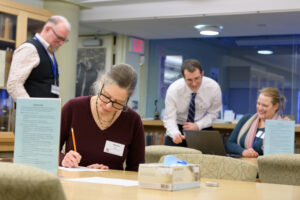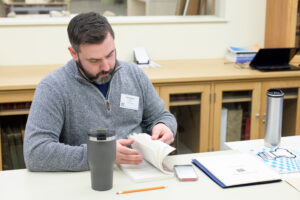Archivists are experts on preserving and accessing the valuable collection of rare materials housed in Trinity College’s Watkinson Library, but a new institute partners archivists with faculty members to generate greater use of the materials.
During the first-of-its-kind institute hosted by the library and held January 10 to 12, four faculty members from Trinity College, Quinnipiac University, and Clark University explored various ways to integrate archival material into their courses.
The faculty pursued the type of hands-on use of the collection that has become somewhat rare in this era of easy access to online materials.
“What we are finding is that a lot of students and faculty do research primarily digitally,” said Eric Stoykovich, manuscript librarian and college archivist. “But the Internet flattens out the experience, in a way.”

Students today may no longer have stacks of books either for classes or pleasure reading in their dormitory rooms, noted Stoykovich. So there is something to be said about getting acquainted–or reacquainted–with tangible items.
Aspects such as paper quality, size, binding, illustrations, and other qualities of bound books are difficult to discern on a 12-by-8-inch laptop computer screen. Some features of the tomes may indicate the intended audience, said Stoykovich. For example, the size of a publication, whether small enough for a pocket, or large enough to fill a table, is likely related to its envisioned audience.
One of the items that Sherry Freyermuth, assistant professor of studio art/graphic design at Clark University, plans to use when teaching “Art and the Alphabet” is a stone tablet with cuneiform letters. A photograph of the tablet could not convey that the item was mere inches in size, the tablet letters dwarfed in size by the size of the typewritten description beside it.
Freyermuth participated in the institute to learn more about how to effectively use archival resources at the liberal arts institution in Worcester, Massachusetts.
“Sometimes when you are teaching you don’t have the time to bounce ideas off of others,” said Freyermuth. “This was exactly what I needed–to hear from the experts about how to do this research in a meaningful way.”
Other materials in the Watkinson Library, such as historic photos, were also identified for use.

When Nicholas Marino, lecturer in the Allan K. Smith Center for Writing and Rhetoric at Trinity College, taught “Visual Rhetorics” in the past, he turned to the Smithsonian Institution collection online for assets.
“But there is so much here from Trinity’s history. Students can interact with photos from our collection,” he said.
In the past, some library-goers have tapped the Watkinson collection to create music from scores that were written in the 1700s, and to create artwork based on writings.
Over the past two decades, there has been a movement to have archivists and librarians be teaching partners, said Eric Johnson-DeBaufre, rare books and special collections librarian. Yet, there are not a lot of programs to teach faculty about working in special collections.
“A lot of this is about getting to see these sources as inspiration,” said Johnson-DeBaufre. “We want to activate learning engagements.”
The first institute will be followed by two others. Applications for the May institute are now open.
